Goodles Shella Good (dry, boxed mac and cheese product in Aged White Cheddar and Shells flavor) tested positive for unsafe levels of Lead and Cadmium. Here’s the August 2024 laboratory report.
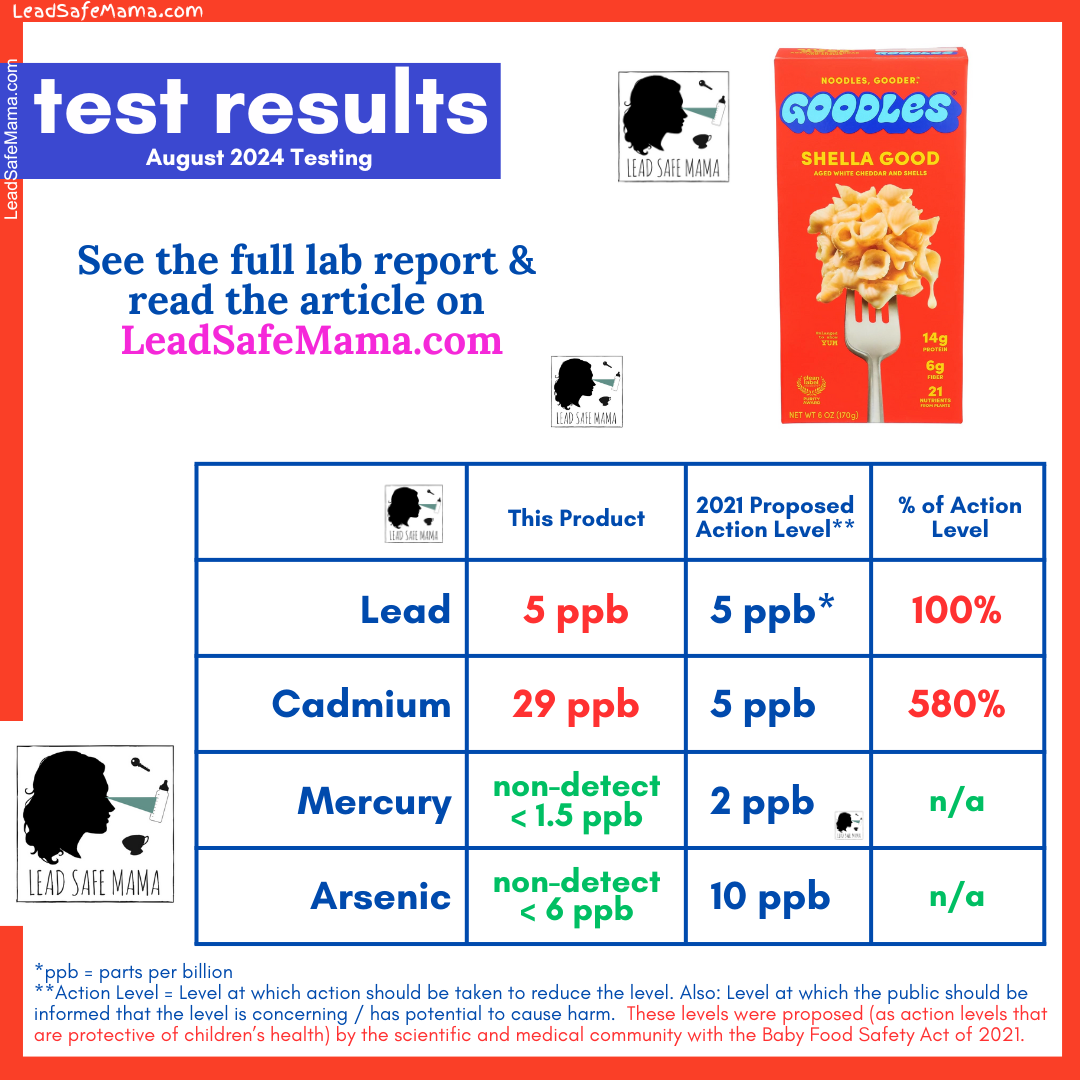
Summary:
When evaluated using the context of the health protective standards (for maximum allowable heavy metal contamination levels) proposed by the medical and scientific community within the Baby Food Safety Act of 2021, this food product should not be considered safe for consumption by children.
Cadmium is a known carcinogen — and has been classified as a carcinogen for more than three decades. The American citizen’s reliance on processed food products to feed their families is particularly alarming (one recent study found that processed foods “now account for more than 60% of daily calories in Americans“) given the pervasiveness of Cadmium contamination in so many U.S-produced processed, packaged food products (both organic and conventional) as revealed through Lead Safe Mama, LLC’s 2024 laboratory food testing initiative. (Click here to see more foods we have tested and the lab reports for each of those products.)
More than a century ago, Lead was identified and classified as a neurotoxin. More recent science has also clearly demonstrated that Lead accumulates in the body over time. Nearly all the Lead our body has been exposed to — through ingestion, inhalation, or transdermal absorption — is still in our body.
In spite of what popular culture health “gurus” might have you believe, Lead is not easily released or “detoxed.” Lead bio-mimics Calcium and the body “efficiently” and actively stores Lead in the place of Calcium when Lead is present — in bones, the brain, and other tissue and organs that are reliant on Calcium to function. This means Lead has the potential to impact all biological systems that are reliant on Calcium (from neurocognitive function to joint function to reproductive functions, and more).
- All U.S. federal agencies agree there is no safe level of Lead exposure for humans (and especially children).
- The CDC “reference level” for Lead poisoning (currently a blood Lead level [BLL] of 3.5 micrograms of Lead per deciliter of blood) is misunderstood by most healthcare practitioners as a level (BLL) below which a child should not be considered poisoned. This is not the case: “The BLRV is simply the level at which a child has more lead in their blood than do most U.S. children (97.5% of children ages 1–5 years).” Read more from that source here.
- In fact, the average BLL of an American child today is in the range of 0.5 micrograms of Lead per deciliter of blood and any BLL of 0.5 or higher is an indicator there has been a likely significant (or persistent) Lead exposure source for that child, an exposure source that should be identified and removed/ eliminated from the child’s life.
- BLL’s in the range of 2.0 and higher have been long-known to cause life-long health impacts, behavioral disorders, and learning disabilities (read more about that here).
- More recent scientific studies have shown long-term negative health impacts with blood Lead levels in the range of 0.4 micrograms per deciliter. You can read more about one related study here.
- We (Lead Safe Mama, LLC) are seeing — in our consulting work with families — how food-based Lead exposures (for children who live in new construction homes, with no identified or suspected potential environmental sources of exposure) often result in a BLL range of 1.0 to 4.0 (micrograms per deciliter).
The concern for Lead-contamination and Cadmium-contamination in our food supply is even more disturbing in light of the recent (August 2024) study demonstrating an increase in 17 specific types of cancer among younger generations (read more info here).
The scientific community has long shared that the best practice to avoid the potential for life-long impacts from Lead exposure is “primary prevention” (avoiding Lead exposure in the first place vs. attempting to repair the impacts of exposure after they have happened). It is therefore the recommendation of Lead Safe Mama, LLC that — given the above considerations — families not feed this product (or similarly toxicant-contaminated products) to their children.
There is no excuse for eating foods contaminated with any measurable level of Lead. There is also no excuse for our government agencies to allow these levels of toxicants in foods, especially foods marketed and sold specifically with the intention they be consumed by children.
For those curious about concerns for toxicant levels in this product related to serving size (an outdated metric for determining food safety), please read this related article.
For those new to the Lead Safe Mama website:
Tamara Rubin is a multiple-federal-award-winning independent advocate for childhood Lead poisoning prevention and consumer goods safety, and a documentary filmmaker. She is also a mother of Lead-poisoned children (two of her four sons were acutely Lead-poisoned in 2005).
- Tamara owns and runs Lead Safe Mama, LLC — a unique community collaborative woman-owned small business for childhood Lead poisoning prevention and consumer goods safety.
- Since July of 2022, the work of Lead Safe Mama, LLC has been responsible for five product recalls (FDA and CPSC).
- All test results reported on this website are science-based, accurate, and replicable.
- Please check out our press page to see some of the amazing coverage of our work so far this year!

This is an ad-free article.
Advertising and affiliate income help Lead Safe Mama, LLC cover the costs of the work we do here (independent consumer goods testing and childhood Lead poisoning prevention advocacy). We have removed ads from most of our more widely-read articles (and newly published articles, too — like this one!) to make them easier for you to read. In addition to supporting this work by starting any shopping you might be doing with a click on our affiliate links, if you would like to support the independent consumer goods testing and childhood Lead poisoning prevention advocacy work of Lead Safe Mama, LLC by making a contribution (which will also help us keep our more widely-read articles ad-free), click here. Thank you!
Important Background: What is an Action Level?
Please note the following key points:
The original lab report for this product is below (at the bottom of this page).
The graphic above shows the levels of metals detected in this product (in red) along with the low threshold of detection (in green) for each metal not detected with the laboratory testing Lead Safe Mama, LLC completed for this product. The numbers are juxtaposed (in blue) to the “Action Level” proposed by the medical and scientific community in 2021 as part of the Baby Food Safety Act.
- These 2021 levels were proposed as “Action Levels” because they are (in fact) protective of human health.
- An “Action Level” is NOT the same as a “Maximum Allowable Level.”
- Many food manufacturers misinterpret guidance on heavy metals to mean “allowable levels” and consider it reasonable for their products to test positive below these levels.
- This is a (perhaps intentional?) misunderstanding/ misinterpretation the food industry makes — a misunderstanding which food manufacturers use to justify the presence of heavy metals in their products.
- There is no safe level of Lead exposure.
- Lead bioaccumulates in the body.
- Lead bio-mimics Calcium in all biological structures.
- If Lead is present, the human body stores it in Calcium-dense biological structures (the brain, bones, organs, teeth, etc.) in place of Calcium.
- Nearly all the Lead you have been exposed to in your life is still stored in your body. You can learn more about this by watching our documentary film on childhood Lead poisoning — linked here.
- It is the cumulative impact of heavy metal exposure (over a lifetime) that makes even small/ incidental/ seemingly trivial exposures particularly damaging and dangerous. You can read more about that here.
- Once a food product has the amount of heavy metal (Lead, Cadmium, Mercury, or Arsenic) noted (above) as the “Action Level,” that food product is officially considered (by the scientific and medical community) unsafe for consumption by children as toxicants (found at-or-above these levels) are in the range of heavy metal levels that have been demonstrated to cause lasting harm.
- Action Levels are unrelated to serving size.
- Action Levels are relevant for any amount of a food product that may be consumed (any quantity of the food in question).
- PPB (parts per billion/ ppb) measurements are a percentage (albeit a very small percentage) and apply to any quantity of the food product tested.
- For more discussion about serving size considerations (and why relying on “serving size” to limit toxicant exposure is not a relevant metric/ not a metric protective of human health), read this article.
- These “Action Levels” proposed in 2021 are the levels at which the scientific and medical community believe the manufacturer (or government) needs to take ACTION to fix the problem.
- One “Action” would be for the manufacturer to take steps toward reducing the levels of toxicants in the food product.
- Another “Action” would be for the manufacturer to cease product sales until the product could be made safe.
- Another “Action” would be for the manufacturer to inform the public that a specific food product has an unsafe level of the metal detected at-or-above the “Action Level” — making a highly-visible public announcement regarding which relevant batches of the product should be recalled and not consumed.
- The Action Levels proposed with the Baby Food Safety Act of 2021 were not arbitrary toxicant levels — they were proposed because they are the levels most protective of human health. The Baby Food Safety Act of 2021, however, was not passed into law.
- Regardless of the fact the Baby Food Safety Act of 2021 never passed into law — and it is therefore legal to have food for children test positive for Lead, Cadmium, Mercury, and Arsenic at-or-above these levels — these Action Levels still reflect the current (modern/ relevant) advice of the medical and scientific communities as levels both achievable by the industry and safeguards of infant and toddler health.
- Food industry lobbyists fought against formalizing these proposed “Action Levels” as a government standard, alleging they were unachievable.
- The image below (with the number ELEVEN) links to a landing page with 11 food products we have already tested this year (2024), all of which have been “non-detect” for toxicants with low thresholds of detection (for Lead, Mercury, Cadmium, and Arsenic) far below the 2021 proposed Action Levels.
- These 11 food products (about 10% of the foods Lead Safe Mama, LLC has tested and reported on so far since March 2024, when we started laboratory testing foods) clearly demonstrate these Action Levels as achievable across a range of food types (flour, coffee, salt, packaged snacks, oats, chia seeds, hemp seeds, beverages, etc).
- The legitimacy of these levels as “Action Levels”/ “Levels of Concern” (even though they were not adopted as law) is further mirrored by the legitimacy of the American Academy of Pediatrics’ level of concern for Lead in water, which is 1 ppb even though the FDA’s official “level of concern” for Lead in water is 15 ppb (you can read more about that here).
For safer snack ideas, click here.
While the packaged, processed food industry would have consumers (and the government) believe the standards proposed in 2021 are unachievable, this industry position (an oft-rearticulated response to nearly every set of laboratory test results for food that we have published to date) is simply not true. It is possible to make safer processed, packaged food products that fall well below the safety levels for toxicants proposed with the Baby Food Safety Act of 2021. To read more about the 11 food items Lead Safe Mama, LLC has tested and reported on so far that tested “non-detect” for Lead, Cadmium, Mercury, and Arsenic (with the limits of detection as reported for each product), click the image below (with the big 11)!
Here also are direct Amazon links to those 11 safer products (this list is growing with the food testing we are organizing, to see the updated list at any time, click the graphic with the number above):
- Sea Salt (Oregon, USA)
- Amazon link for this product: https://amzn.to/4dcbk5L
- Article with the lab test report for this product
- Organic Einkorn Flour (Italy)
- Amazon link for this product: https://amzn.to/3LIqxix
- Article with the lab test report for this product
- Organic, Gluten-Free, Sprouted Rolled Oats (Canada)
- Amazon link for this product: https://amzn.to/3WIQ1BN
- Article with the lab test report for this product
- Organic, Non-GMO, Gluten-Free Chia Seeds (Mexico)
- Amazon link for this product: https://amzn.to/3YvE7xC
- Article with the lab test report for this product
- Organic Espresso Roast Ground Coffee (Multi-Country Origin, Non-USA)
- Amazon link for this product: https://amzn.to/3yo1eiL
- Article with the lab test report for this product
- Sparkling Grape-Flavored Tonic
- Amazon link for this product: https://amzn.to/4cjFYZu
- Article with the lab test report for this product
- Pure Organic Layered Fruit Bars in Strawberry Banana Flavor
- Amazon link for this product: https://amzn.to/3WQEekA
- Article with the lab test report for this product
- Pure Organic Layered Fruit Bars in Raspberry Lemonade Flavor
- Amazon link for this product (sold in a box assortment, we haven’t found these sold separately): https://amzn.to/3XcFsIp
- Article with the lab test report for this product
- GoGo Squeez Organic Fruit On The Go in AppleApple Flavor
- Amazon link for this product: https://amzn.to/3XhWYLe
- Article with the lab test report for this product
- Organic Soy Milk
- Amazon link for this product: https://amzn.to/4dwev8l
- Article with lab report to be published shortly
- Organic Hemp Seeds
- Amazon link for this product: https://amzn.to/4e05RP9
- Article with lab report to be published shortly
Published: September 8, 2024
Sunday
Hello! We are working on publishing a LOT of food test results very quickly this week.
We may be updating this section of each article published this week (with more information about the specific product and other similar products for context) in the future (especially as we have aggregate data about more food products in this category to share), but we wanted to make sure the greater Lead Safe Mama community (and the general public) had access to the scientific data provided in these lab reports (about foods and supplements they may have in their home) as quickly as possible.
“I have been feeding this to my child! How can I ‘detox’ them/ what can I do?”
- Please note: Lead Safe Mama, LLC and Tamara Rubin are not healthcare providers/ medical practitioners and do not represent themselves as so. Instead, we share scientific findings from the greater global scientific community and ask that you evaluate those on their merits, discussing any medical decisions with your child’s doctor.
- With the above disclaimer noted, if your child has been eating this product (or any other confirmed or suspected Lead-contaminated foods) and they can tolerate garlic, you may want to increase their garlic consumption.
- Roasted garlic spread on toast
- Garlic on pizza
- Garlic on pasta
- Garlic in green smoothies
- Chopped garlic on veggies
- Most “detox” products and potions on the market simply do not work (they are snake oil products designed to separate desperate parents from their hard-earned cash). Some detox products are also heavily Lead-contaminated and may result in a child being Lead-poisoned.
- Please stay away from these types of detox products (any packaged/ manufactured “detox” product sold by a company).
- Science has repeatedly demonstrated (in multiple scientific studies from around the globe) that simply increasing the consumption of garlic (in any form, cooked or raw) to help with the elimination/ excretion of heavy metals (and specifically Lead) may be significantly beneficial after a known or suspected exposure (read more about that here).
- Blueberries have also been scientifically demonstrated as a helpful “natural detox” (when my children were babies I used to serve them frozen organic blueberries with a little bit of cream [or soy milk] drizzled over the top, which then freezes and turns it into an “ice cream”-like treat)!
- It is also always prudent to ask your doctor about getting a heavy metals panel (blood or urine) for anyone who has been eating contaminated foods — especially if you have not had one recently as a baseline.
Please scroll down to see the full lab report for the product pictured above.
Please do check out the other links on this page (below and above) for additional information about the truly independent, third-party, laboratory testing we are conducting on food products and other ingested items (including supplements and vitamins).
As there are almost no reasonable safety thresholds proposed for toxicants (heavy metals) consumed by adults (in foods and supplements), our focus is (as always) on the health of children.
Some additional reading & links that may be of interest:
- This is our article with guidance for safer food choices in general.
- This is our article with lists of possible safer food choices.
- This is our article with safer snack ideas for children.
- This is the Lead Safe Mama affiliate link to purchase the test kits we used for this laboratory testing.
- Here’s our landing page with links to all the food test results for products we have tested and reported on so far.
- Here’s our landing page listing all the food testing we have in-progress (at the lab/ pending, etc.) — please consider making a contribution in support of any of the pending crowd-funded foods if they are a food you use! Thank you.
- Here’s information on how to send your own food samples into a lab (the cost is $195 per single food sample tested for Lead, Cadmium, Mercury, and Arsenic) and how to collaborate with Lead Safe Mama, LLC on the food testing we are organizing.
Amazon links are affiliate links. If you purchase something after clicking on a Lead Safe Mama, LLC Amazon affiliate link, Lead Safe Mama, LLC may receive a percentage of what you spend — at no extra cost to you.
Lab report for Goodles Shella Good (dry boxed macaroni and cheese product) in Aged White Cheddar And Shells flavor, as pictured:
Never Miss an Important Article Again!
Join our Email List





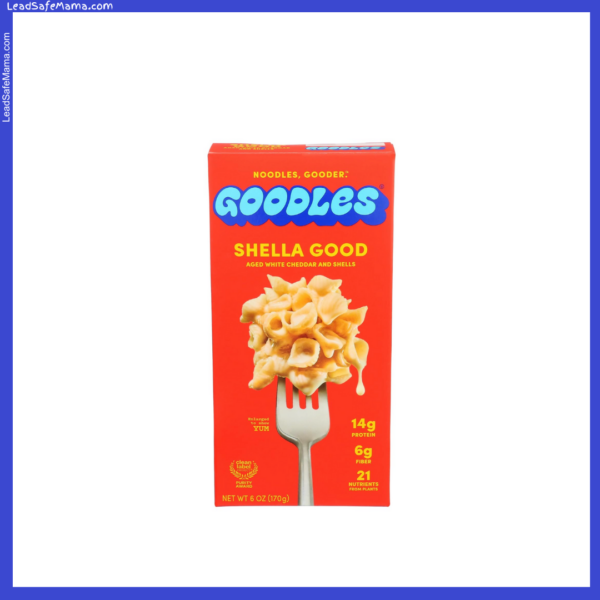
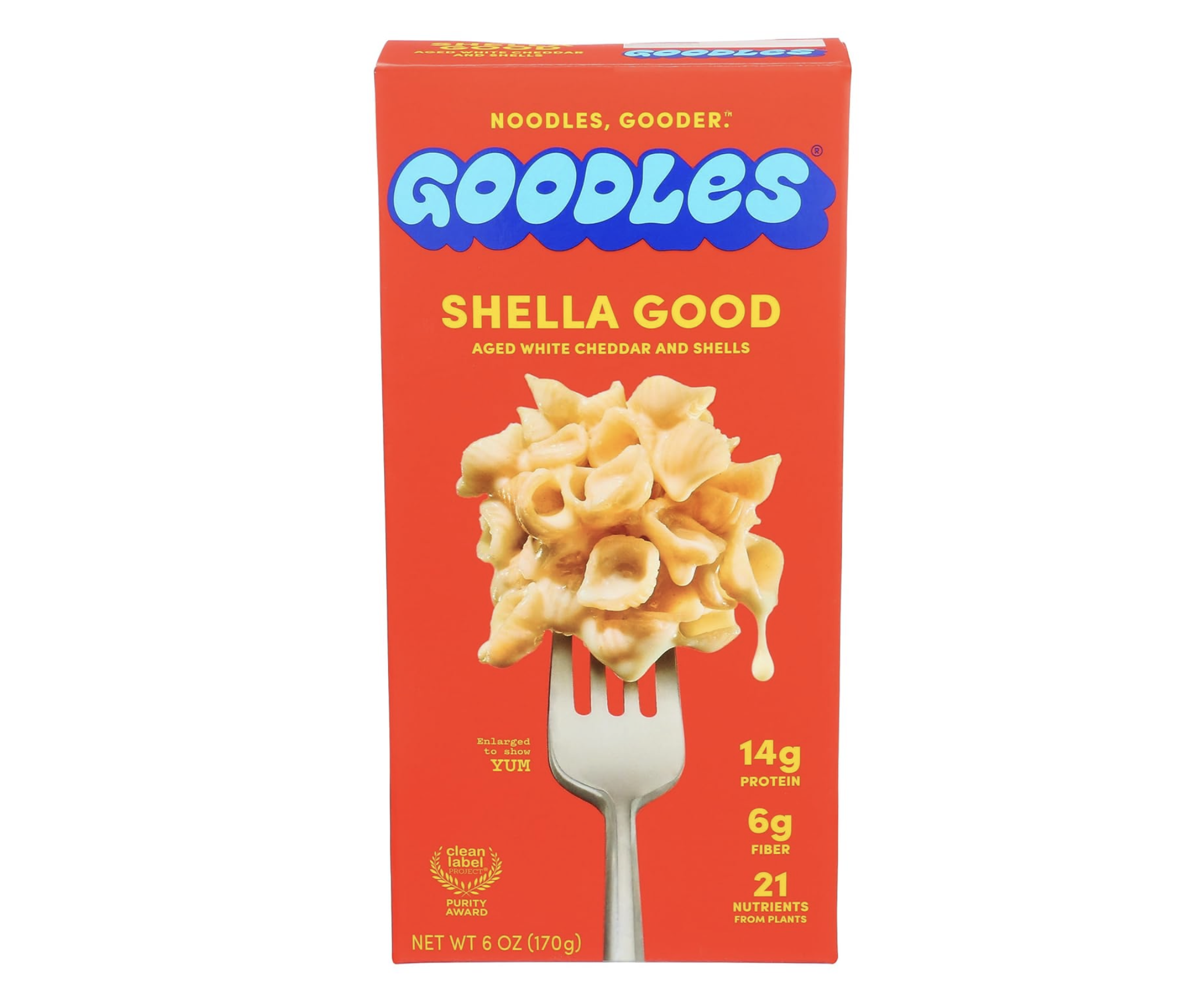
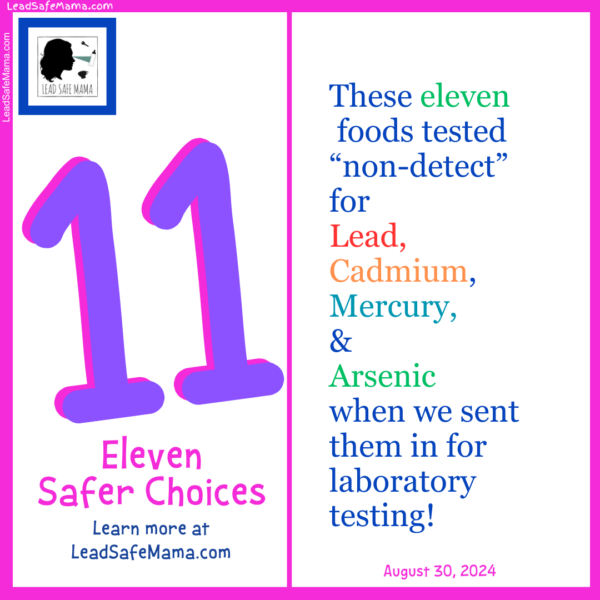
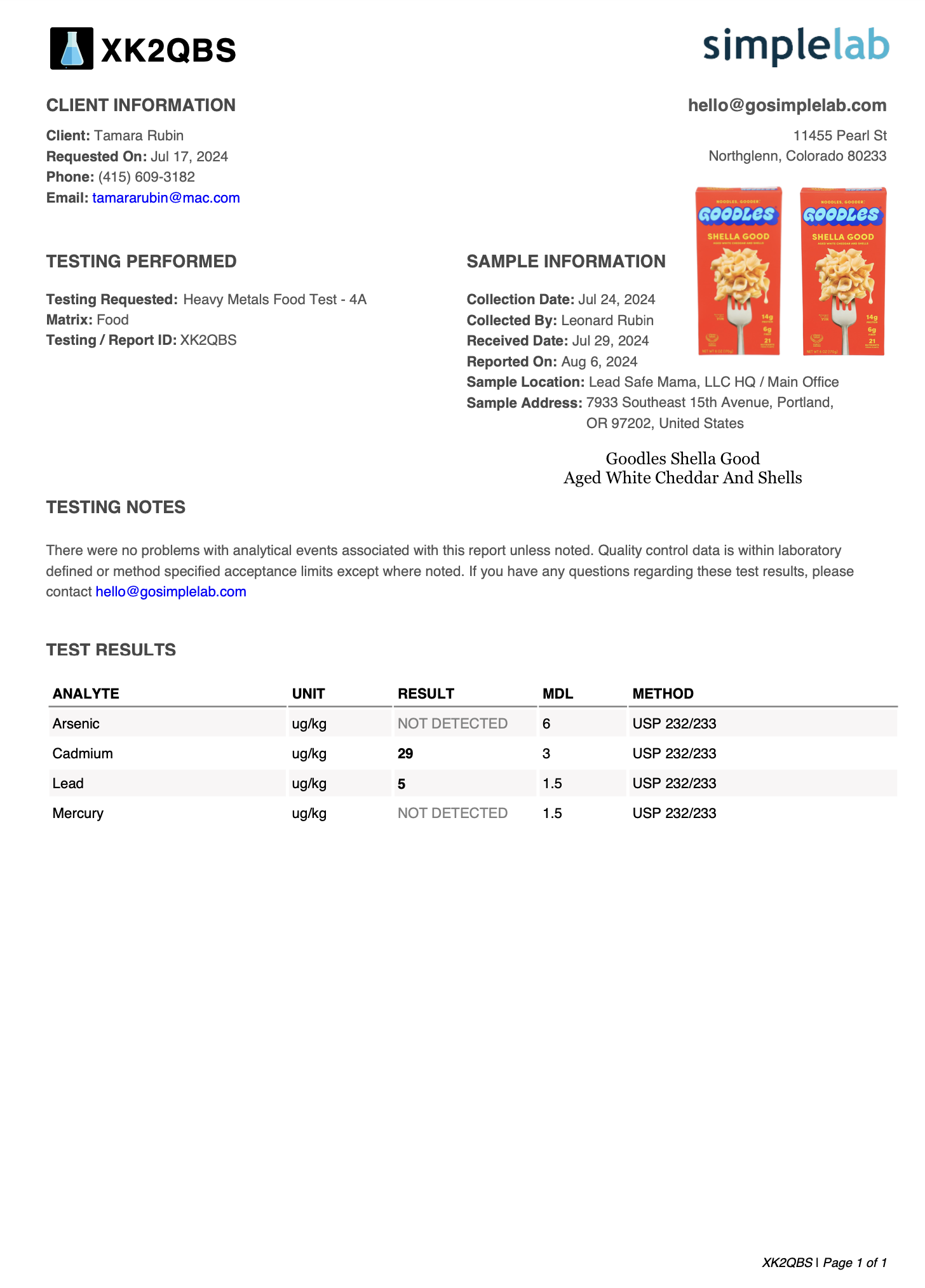

I’m so upset, my kids love these…
I’m so sorry. Up the garlic intake. Pasta in general is not a good choice. Look into the Jovial Einkorn pastas – we have not tested them yet, but I expect they will test similarly to their einkorn flour – which is the best flour we have tested to date. Get the kids tested too (ask their doctor for a full heavy metals panel). Emphasize more fresh fruits and veggies moving forward (I never cook any pasta for my kids anymore).
T
Since the flour tested so far tested positive for Cadmium, is there a chance flour milled in Italy might have a better outcome. Since most of the pasta comes from Italy, can we test a brand of pasta that might be popular amongst the community?
Did you see the test results for the Jovial Einkorn flour?
Yes thank you! I was so happy to see the results for the Einkorn, since then I’ve been exclusively using the Jovial einkorn flour. I’m no longer purchasing all purpose. I have wheat berries, but now I’m questioning if the ceramic that grinds the flour inside my mockmill makes it’s way into the flour. For now I’m sticking with einkorn from Jovial.
My husband and one of my kids is obssesed with mc and cheese. I have slowly taken them off pasta but we have consumed SO much. We eat a lot of garlic too but still… I wonder how Kraft will test.
We will know shortly.
T
Can you clarify if the pasta shells or the cheese powder tested positive? We have some boxes and deciding if we can at least use the cheese with another pasta, or chickpea pasta. Thanks!
We tested the product as a whole – not as separate components.
T